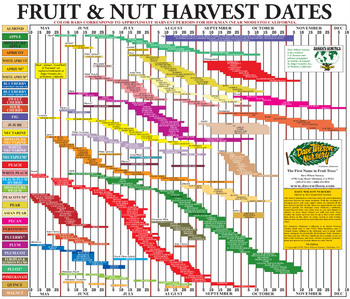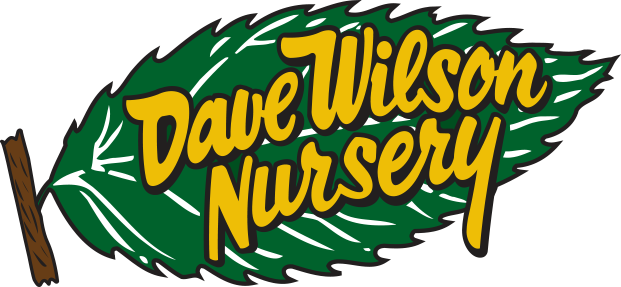We sell our products to retail nurseries, garden centers, container growers who sell to landscape contractors and retail nurseries, mail order nurseries, and anyone else who qualifies. We do not accept direct sales to consumers.
So many fruit varieties - which ones to choose? Does rootstock matter? Trees well-chosen will be easiest to grow and give superior fruit - at your preferred harvest times.
About Varieties
Start with varieties adapted to your area.
Do you need cold hardy varieties or late-bloomers to avoid late frosts or heavy rains? Are you in a warm winter area that requires low-chill varieties? Are your summers too cool for some peaches? Be sure to consider varieties with known pest and disease resistance when available. For reliability, sometimes lesser-known varieties are the best choices.
Learn about fruit tree chilling requirements, especially if you live in a spring-frost or warm-winter climate.
Consult your agricultural extension office publications and ask their Master Gardener fruit specialists for ideas and recommendations about what to grow. Plant descriptions on this site and elsewhere often refer to USDA Plant Hardiness Zones. For much of the western U.S., a good starting point for research might be our list of Most-Ordered DWN Home Fruit Varieties for your state.
Find a retail nursery that specializes in fruit trees chosen for your area. Attend a fruit tree seminar to meet other local home growers. Travel out of town to a good fruit tree nursery if necessary.
Visit fruit stands and farmers markets for ideas about what is being grown locally.
When would you like the fruit to ripen?
 Is your goal successive ripening - one variety after another for a long season of tree-ripe fruit? June through September? May through October? At some point in the season do you want several kinds all at once for fruit salads and sharing? The chart of Fruit & Nut Harvest Dates is a key tool for home orchard planning. (Remember, exact dates vary with local climate and site conditions, especially sun exposure.) Printed harvest date charts may be purchased.
Is your goal successive ripening - one variety after another for a long season of tree-ripe fruit? June through September? May through October? At some point in the season do you want several kinds all at once for fruit salads and sharing? The chart of Fruit & Nut Harvest Dates is a key tool for home orchard planning. (Remember, exact dates vary with local climate and site conditions, especially sun exposure.) Printed harvest date charts may be purchased.
Be sure to plant some taste test winners.
Along with varieties proven for your area, be sure to plant some of the new taste-test winners likely to perform in your climate. (See the latest Fruit Tasting Report.) One of the main reasons to grow fruit at home is to have what is not otherwise available – a season-long supply of the tastiest varieties, tree-ripened. If you have fruit-growing friends, you could divvy up the taste test winners you want to test in your area.
Some DWN fruit variety recommendations:
The article Recommendations for USDA Plant Hardiness Zones 5-9 highlights some lesser-known but widely adaptable varieties - some old and some new.
Tom's Pick's - Winners for the Low-Chill Southwest describes Tom Spellman’s selections for the warm-winter Southwest: a sequence of proven varieties that produce quality fruit from mid-May through October.
Plant Edible Ornamentals to add distinction and beauty to your landscape.
About Rootstocks
In many planting locations, rootstock is the most important part of a fruit tree. If a tree’s rootstock is ill-suited to the conditions it must grow in, nothing else is likely to matter – a sensational variety or a "semi-dwarf" rootstock is of no value if the tree dies.
When choosing fruit tree rootstocks, the most important considerations are:
soil adaptation
disease resistance
anchorage
Other factors which may be relevant, but not critical:
enhanced productivity
precocity (bearing at a young age)
dwarfing effect
> > >The no. 1 reason people lose fruit trees is water-saturated soil. < < <
The remedies are:
ensure adequate drainage
do not overwater
plant wet-soil tolerant rootstocks
The most important thing to know about your planting site is how well the soil drains.
If your soil tends to remain wet for extended periods due to slow drainage and/or a rainy climate, you must plant trees with rootstocks tolerant of wet soil. (See Planting Your Backyard Orchard.)
If you are not sure about your soils or which rootstocks to choose, consult your ag extension office, your Master Gardener fruit specialist and/or a local retail nursery that specializes in fruit trees.
Rootstocks should not be chosen primarily for their dwarfing effect.
A "semi-dwarf" tree is not sufficiently size-controlled, anyway. If a semi-dwarf tree will "only" grow to 12-15 ft. high, that’s still way too big for most home fruit growers.
For most people, to be able to do the pruning, thinning and picking while standing on the ground or a low stool, the trees must be kept under eight feet tall. With very few exceptions, this is not accomplished by dwarfing rootstocks - but it can be achieved by summer pruning!
Related Content
Fruit & Nut Harvest Dates (chart) + Variety & Rootstock Description Book
Recommendations for USDA Plant Hardiness Zones 5-9
Tom's Pick's - Winners for the Low-Chill Southwest
